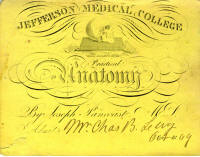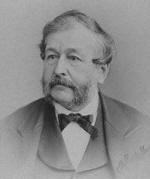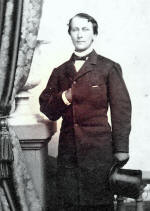Joseph Pancoast, M.D.

Click on image to enlarge
 PANCOAST, Joseph, surgeon, born in
Burlington county, New Jersey, in 1805; died in Philadelphia,
Pennsylvania, 7 March, 1882. He was graduated at the medical department
of the University of Pennsylvania in 1828, practised as a surgeon in
Philadelphia, and in 1831 began to teach classes in practical anatomy
and surgery, he was chosen one of the physicians of the Blockley
hospital in 1834, soon afterward was made head physician of the
children's hospital connected with it, and from 1838 till 1845 was one
of the visiting surgeons. In 1838 he was elected professor of surgery in
Jefferson medical college, and in 1847 was transferred to the chair of
anatomy, which he filled till 1874, when he was succeeded by his son,
William H. Pancoast. PANCOAST, Joseph, surgeon, born in
Burlington county, New Jersey, in 1805; died in Philadelphia,
Pennsylvania, 7 March, 1882. He was graduated at the medical department
of the University of Pennsylvania in 1828, practised as a surgeon in
Philadelphia, and in 1831 began to teach classes in practical anatomy
and surgery, he was chosen one of the physicians of the Blockley
hospital in 1834, soon afterward was made head physician of the
children's hospital connected with it, and from 1838 till 1845 was one
of the visiting surgeons. In 1838 he was elected professor of surgery in
Jefferson medical college, and in 1847 was transferred to the chair of
anatomy, which he filled till 1874, when he was succeeded by his son,
William H. Pancoast.
From 1854 till 1864 he was one of the surgeons to
the Pennsylvania hospital. Dr. Pancoast was the originator' of an
operation for soft cataract with a fine needle, bent near the point. He
devised many new operations in plastic surgery, among them the formation
of a nose by means of the plough and groove or plastic suture,
introduced in 1841; a substitute for the eyebrow, formed from a flap of
the scalp; the introduction of a catheter for empyema into the pleura by
raising a flap of the integuments over the ribs; turning down flaps from
the skin of the abdomen for the relief of exstrophy of the bladder,
which was first performed by him in 1868 ; and the raising of a flap
over the coronoid process, and the removal of that process and part of
the lower jaw in order to divide the trunks of the nerves that cause
pain in facial neuralgia. He discovered that in some cases of strabismus
the internal oblique muscle must be cut. He has restored the voice by
dividing the muscles of the soft palate that have become contracted from
ulceration. He also devised an abdominal tourniquet, which he first used
in 1860, for compressing the aorta, and thus preventing" death from loss
of blood in amputation at the hip-joint or upper thigh.
He was a member
of the American philosophical society, and of various medical and
scientific associations. Besides numerous contributions to the "American
Journal of the Medical Sciences," the "American Medical Intelligencer,"
and the "Medical Examiner," essays and introductory lectures to his ,
:lassos, of which the most notable was "Professional Glimpses Abroad,"
and various pathological and surgical monographs and reports of new
operations, he published a translation from the Latin of J. Frederick Lobstein's "Treatise on the Structure, Functions, and Diseases of the
Human Sympathetic Nerve" (Philadelphia, 1831); "Treatise on Operative
Surgery, including Descriptions of all the New Operations," his greatest
work (1844; revised ed., 1852); and "A System of Anatomy for the Use of
Students," based on the work of Casper Wistar (1844). He edited "Manet
on the Great Sympathetic Nerve "; the "Cerebro-Spinal Axis of Man," by
the same author (1841) ; and "Quain's Anatomical Plates" (1852).
 |
His son, shown here at
age 26, William Henry, was a surgeon, born in Philadelphia,
Pennsylvania, 16 October, 1835, graduated at the Jefferson
medical college in 1856, studied for three years in London,
Paris, and Vienna, and on his return established himself in
practice in Philadelphia, and acquired a high reputation as
a bold, rapid, and skilful operative surgeon, conservative
in treatment and seldom mistaken in diagnosis.
He served in the Union
Army as an Assistant Surgeon. |
Edited Appletons Encyclopedia, Copyright © 2001 VirtualologyTM
|